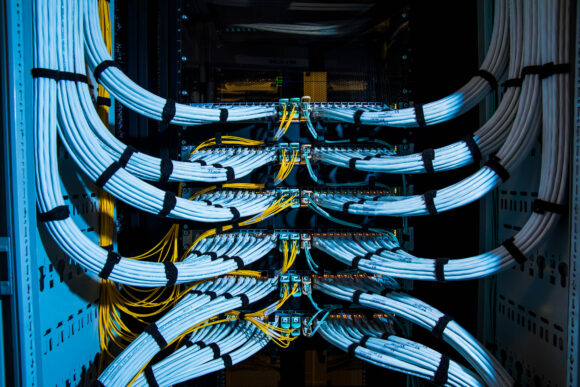Microsoft Corp.’s data-center crunch will continue for longer than the company has previously outlined, underscoring the software giant’s struggles to keep up with cloud demand.
Many of Microsoft’s US data center regions are experiencing shortages of physical space or servers, according to people familiar with the company’s internal forecasts. New subscriptions for Azure cloud services are restricted in some crucial server-farm hubs, including Northern Virginia and Texas, through the first half of next year, said the people who requested anonymity to discuss internal forecasts.
That’s a longer time frame than the company has previously outlined. In July, Chief Financial Officer Amy Hood said current constraints would continue through the end of 2025. The lack of capacity affects machines running graphics processing units typically used for artificial intelligence as well as data centers dominated by central processing units that have long been the workhorse chips for traditional cloud services, the people said.
Azure is Microsoft’s most important growth engine — the cloud unit generated more than $75 billion during the 2025 fiscal year. Its expansion has outpaced its biggest rivals, Amazon.com Inc. and Alphabet Inc.’s Google.
A lack of servers to rent out to customers has been a recurring concern for cloud providers in recent years. During the last six quarterly earnings calls, Microsoft has said it was unable to meet all of its customers’ cloud demand. Amazon and Google have described similar constraints.
Related: Lack of Proper Insurance Coverage for Data Centers Presents Pitfalls
A Microsoft spokesperson said that a majority of Azure services and regions in the US “have available capacity so that existing customers with deployed workloads can continue to grow.” In some cases of unplanned demand spikes, the company will introduce “capacity preservation methods” to balance customer demand across its data center fleet, the spokesperson said.
Azure customers select data-center regions based on physical proximity and what software is available. When a preferred facility lacks space, Microsoft salespeople point customers toward others with capacity, according to internal guidance. But these workarounds can increase complexity and the amount of time it takes data to travel between a server farm and the customer, said people familiar with the work.
In some cases, customers experiencing Azure capacity issues take their business elsewhere, according to Apurva Kadakia, who helps companies set up cloud workloads as global head of cloud and partnerships at Hexaware Technologies. Some tap multiple Azure regions or send only critical workloads to the cloud until more capacity is available, he said.
“Our teams periodically work with large customers to plan around demand spikes, like holiday periods, to guide them to the most appropriate regions” and products, the Microsoft spokesperson said. “In unusual cases where customers face increased cost or latency, Microsoft will compensate them for additional expense.”
Microsoft has been on a historic building spree to get data centers online — adding more than two gigawatts of capacity over the last year, roughly equivalent to the power output of the Hoover Dam.
“It’s been almost impossible to build capacity fast enough since ChatGPT and GPT-4 launched,” Chief Technology Officer Kevin Scott said in early October, referring to OpenAI’s popular chatbot and the AI model that runs it. “Even our most ambitious forecasts are just turning out to be insufficient on a regular basis.”
AI’s intense computing demands have fueled much of the need for new data centers. But Microsoft also faces a crunch in demand for its traditional cloud infrastructure, which underpins applications and websites across the internet.
For these CPU-based workloads, OpenAI is Microsoft’s largest customer, according to people familiar with the company’s operations.
Microsoft also uses significant computing resources to host its own workloads and applications such as the Office suite. Some Microsoft employees have been told to close internal projects in impacted regions to save capacity, according to people familiar with the matter.
It can take years to bring a data center online from initial planning to turning the servers on. Several crucial components for data centers, ranging from the semiconductors themselves to electricity infrastructure like transformers, are subject to long delivery times, according to people familiar with the process.
Exceptions can be made for key customers who want additional capacity in Azure regions with supply crunches, the people familiar said. Availability is much better outside the US. For example, many of Microsoft’s European regions can handle new customer subscriptions without restriction.
During a July earnings call, finance chief Hood said that continual supply shortages were due to increasing demand. “I talked about it — my gosh — in January and said I thought we’d be in better supply-demand shape by June,” she said during the July call. “And now I’m saying — I hope I’m in better shape by December.”
Photo: Photo credit: Jason Alden/Bloomberg
Topics Trends
Was this article valuable?
Here are more articles you may enjoy.



 APCIA Chair Robusto: Industry Must Fight False Narratives, Improve Public Trust
APCIA Chair Robusto: Industry Must Fight False Narratives, Improve Public Trust  Workers’ Compensation Continues to Lead P/C Industry With Strong Profits
Workers’ Compensation Continues to Lead P/C Industry With Strong Profits  J&J Must Pay $966M After Jury Finds Company Liable In Talc Cancer Case
J&J Must Pay $966M After Jury Finds Company Liable In Talc Cancer Case  Acrisure to Lay Off 400 Employees, Citing Tech Advancements and AI Integration
Acrisure to Lay Off 400 Employees, Citing Tech Advancements and AI Integration 

